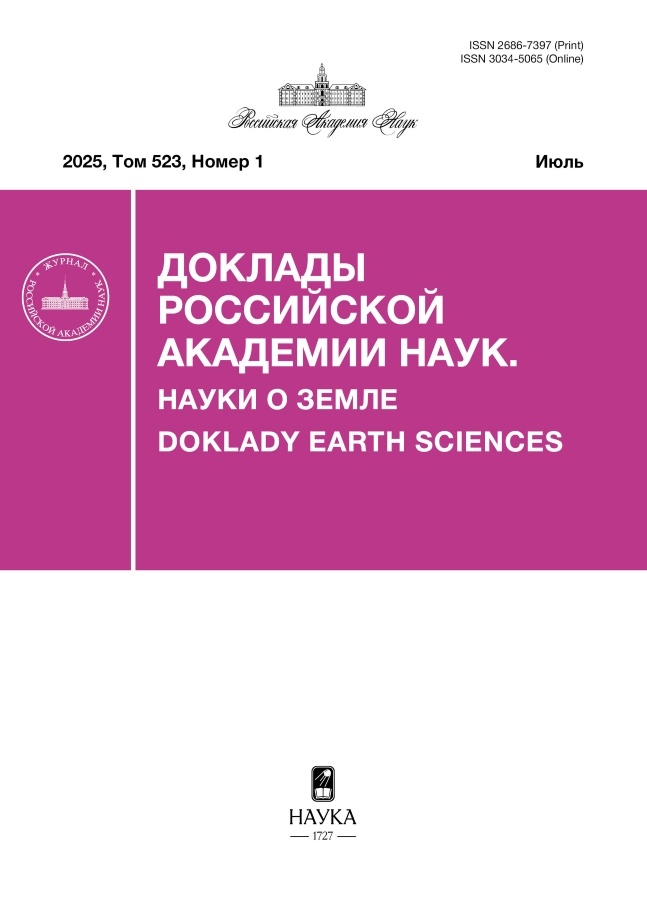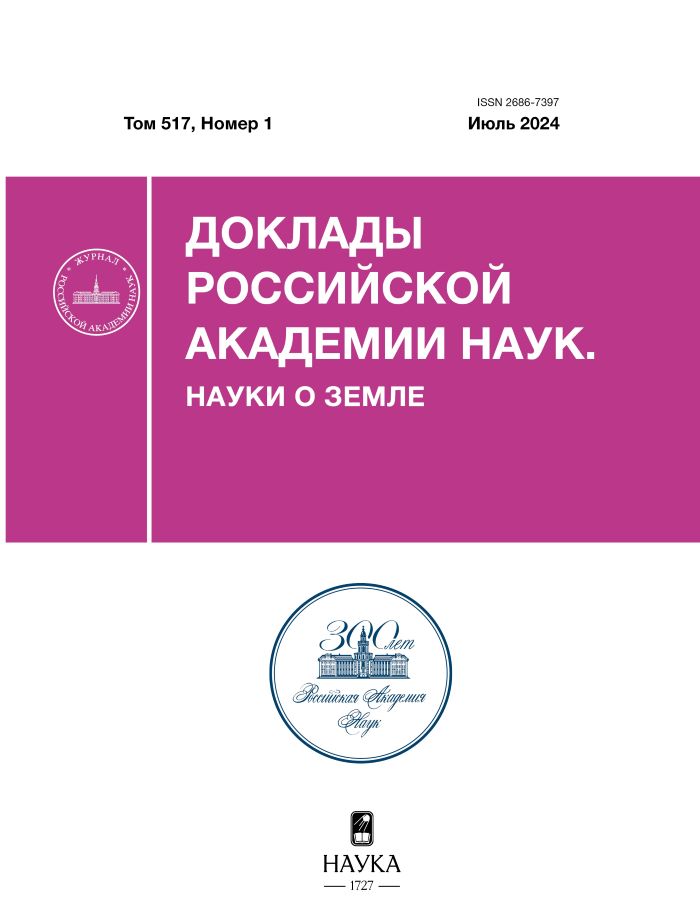Геодинамический режим восточной пассивной части сдвоенного трансформного разлома Чарли Гиббс (Северная Атлантика)
- Авторы: Соколов С.Ю.1, Денисова А.П.1,2, Патина И.С.1
-
Учреждения:
- Геологический институт РАН
- Московский Государственный Университет им. М.В. Ломоносова
- Выпуск: Том 517, № 1 (2024)
- Страницы: 125-133
- Раздел: ГЕОДИНАМИКА
- Статья получена: 31.01.2025
- Статья опубликована: 13.12.2024
- URL: https://ter-arkhiv.ru/2686-7397/article/view/650008
- DOI: https://doi.org/10.31857/S2686739724070131
- ID: 650008
Цитировать
Полный текст
Аннотация
Изучение особенностей неотектонических деформациий осадочного чехла и сейсмичности сдвоенного трансформного разлома Чарли Гиббс показало, что его южный трог развивается в режиме транстенсии, а северный – в режиме транспрессии. Признаки активности в строении верхней части разреза осадков отмечены в восточных пассивных частях разлома на удалении не менее 150 км от рифтовой зоны Срединно-Атлантического хребта. В осадочном разрезе южного трога проявлены дислокации сбросовой кинематики, отмечены признаки увеличенной скорости осадконакопления и присутствуют оползневые обломочные отложения вблизи склонов трога. В осевой части северного трога установлен медианный хребет со складчатыми структурами, перекрытыми осадками с угловым несогласием. Разломы к югу от хребта интерпретируются как взбросы. В северном троге на современном этапе формируется цепочка выступов медианного хребта при выжимании глубинного вещества и сопутствующими деформациями осадочного чехла.
Полный текст
Об авторах
С. Ю. Соколов
Геологический институт РАН
Автор, ответственный за переписку.
Email: sysokolov@yandex.ru
Россия, Москва
А. П. Денисова
Геологический институт РАН; Московский Государственный Университет им. М.В. Ломоносова
Email: sysokolov@yandex.ru
Географический факультет
Россия, Москва; МоскваИ. С. Патина
Геологический институт РАН
Email: sysokolov@yandex.ru
Россия, Москва
Список литературы
- USGS Search Earthquake Catalog. 2022. (Выборка 2022.11.17) https://earthquake.usgs.gov/earthquakes/search
- Aderhold K., Abercrombie R. E. The 2015 Mw 7.1 earthquake on the Charlie-Gibbs transform fault: Repeating earthquakes and multimodal slip on a slow oceanic transform // GRL. 2016. V. 43. P. 6119–6128. doi: 10.1002/2016GL068802
- GEBCO 30” Bathymetry Grid. Version 20141103. 2014. (http://www.gebco.net)
- Пущаровский Ю. М., Пейве А. А., Разницин Ю. Н., Базилевская Е. С. Разломные зоны Центральной Атлантики // Труды ГИН. 1995. Вып. 495. 160 с.
- Ligi M., Bonatti E., Gasperini L., Poliakov A. N. B. Oceanic broad multifault transform plate boundaries // GSA. Geology. 2002. V. 30. No 1. P. 11–14. doi: 10.1130/0091-7613(2002)
- Сколотнев С. Г., Санфилиппо А., Пейве А. А., Мучини Ф., Соколов С. Ю., Сани К., Добролюбова К. О., Феррандо К., Чамов Н. П., Перцев А. Н., Грязнова А. С., Шолухов К. Н., Бич А. С. Новые данные по строению мегатрансформной системы Долдрамс (Центральная Атлантика) // Доклады РАН. Науки о Земле. 2020. Т. 491. № 1. С. 29–32. doi: 10.31857/S2686739720030184
- Соколов С. Ю., Чамов Н. П., Хуторской М. Д., Силантьев С. А. Индикаторы интенсивности геодинамических процессов вдоль Атлантико-Арктической рифтовой системы // Геодинамика и тектонофизика. 2020. Т. 11. № 2. С. 302–319. doi: 10.5800/GT-2020-11-2-0476
- Müller R. D., Sdrolias M., Gaina C., Roest W. R. Age, spreading rates, and spreading asymmetry of the world’s ocean crust // Geochemistry, Geophysics, Geosystems G3. 2008. V. 9. № 4. P. 1–19. doi: 10.1029/2007GC001743.
- Scotese C. Atlas of Earth History. Vol. 1. Paleogeography. Arlington: PALEOMAP Project, 2001. 58 p. ISBN: 0-9700020-0-9
- Dang Z., Zhang N., Li Z. X., Huang C., Spencer C. J., Liu Y. Weak orogenic lithosphere guides the pattern of plume-triggered supercontinent break-up // Nature Communications. Earth & Environment. 2020. 1:51. doi: 10.1038/s43247-020-00052-z.
- Storey B. The role of mantle plumes in continental breakup: Case histories from Gondwanaland // Nature. 1995. V. 377. P. 301–308. 10.1038/377301a0.
- Schaeffer A. J., Lebedev S. Global shear speed structure of the upper mantle and transition zone // Geophys. J. Int. 2013. V. 194. № 4. P. 417–449.
- Соколов С. Ю., Добролюбова К. О., Турко Н. Н. Связь поверхностных геолого-геофизических характеристик с глубинным строением Срединно-Атлантического хребта по данным сейсмотомографии // Геотектоника. 2022. № 2. С. 3–20. doi: 10.31857/S0016853X22020060
- Skolotnev S. G., Sanfilippo A., Peyve A. A., Nestola Y., Sokolov S. Yu., Petracchini L., Dobrolyubova K. O., Basch V., Pertsev A. N., Ferrando C., Ivanenko A. N., Sani C., Razumovskiy A. A., Muccini F., Bich A. S., Palmiotto C., Brusilovsky Yu. V., Bonatti E., Sholukhov K. N., Cuffaro M., Veklich I. A., Dobrolyubov V. N., Ligi M. Seafloor Spreading and Tectonics at the Charlie Gibbs Transform System (52-53°N, Mid Atlantic Ridge): Preliminary Results from R/V A. N. Strakhov Expedition S50 // Ofioliti. 2021. V. 46 (1). P. 83–101. doi: 10.4454/ofioliti.v46i1.539
- Баширова Л. Д., Дорохова Е. В., Сивков В. В., Андерсен Н., Кулешова Л. А., Матуль А. Г. Палеотечения в районе разлома Чарли-Гиббс в позднечетвертичное время // Океанология. 2017. Т. 57. № 3. С. 491–502.
- Пейве А. А., Соколов С. Ю., Иваненко А. Н., Разумовский А. А., Патина И. С., Боголюбский В. А., Веклич И. А., Денисова А. П., Добролюбов В. Н., Докашенко С. А., Иванова Е. С., Лапина С. А., Наумов И. А., Никитин Н. С., Уразмуратова З. Ф. Аккреция океанической коры в Срединно-Атлантическом хребте (48°–51.5° с.ш.) в ходе “сухого” спрединга // Доклады Российской Академии Наук. Науки о Земле. 2023. Т. 508. № 2. С. 155–163. doi: 10.31857/S2686739722602083
- Соколов С. Ю. Тектоника и геодинамика Экваториального сегмента Атлантики. (Труды ГИН РАН: вып. 618) М.: Научный мир, 2018. 269 с.
Дополнительные файлы
















